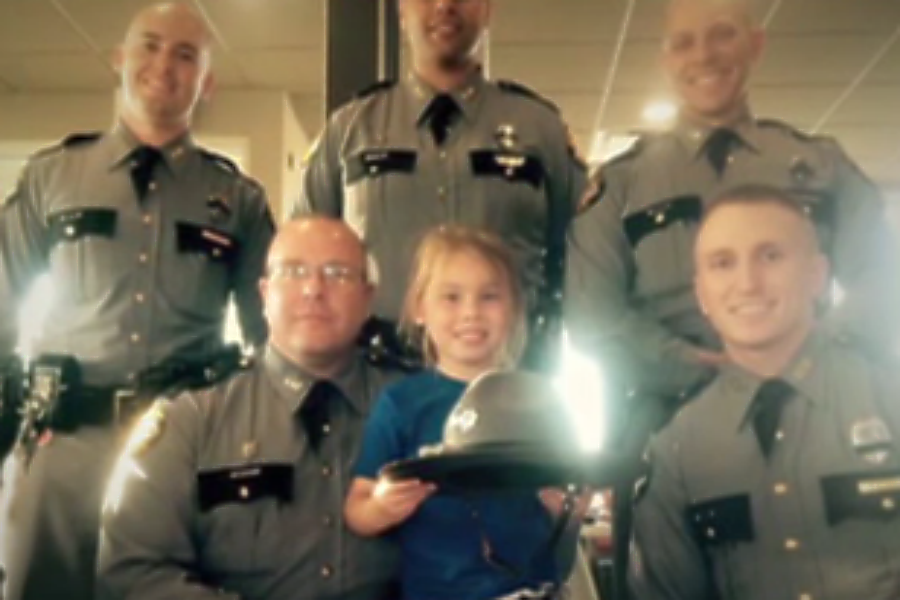Why a 5-year old bought ice cream for police, and other pro-police acts
Loading...
On Friday Isabella Gregory, age 5, used her allowance to buy ice cream for seven officers at a McDonald's in Radcliff, Ky., because she knew from a massive outpouring of public support that the police had just come from the funeral of a fallen officer.
Kentucky State Police trooper Joseph Cameron Ponder was shot to death during a traffic stop.
This small act from a child gained viral media attention this week for its charming innocence and compassion for grieving police officers. But support for the police has taken on a harder edge elsewhere – and is prompting criticism from some black civil rights advocates.
For example, some police backers have taken to spray-painting blue lines on curbs as part of the viral Safe Harbor Initiative started by Anthony Welichko of San Antonio, Texas, earlier this month after attacks on police there.
“To all law enforcement who see this line, know that the residents of this home appreciate your service and dedication to keeping the peace!” Mr. Welichko wrote in his Facebook status. “Know that when you enter the neighborhood and see these lines that you are not alone or without ‘back-up.’ We do not need the media to make our voices of support for our police and emergency services heard (though it would be nice). Lastly, if you are in my neighborhood and mean to harm a member of law enforcement, know that decision may be hazardous you [sic] health as someone has that officers [sic] back!"
There is also an ongoing Twitter battle for hashtag supremacy between #BlackLivesMatter and the co-opted #PoliceLivesMatter.
Civil rights attorney and former police officer Caree Harper of Los Angeles, Calif., says in a phone interview that while she still holds a deep kinship with law enforcement, she sees the Safe Harbor Initiative and comments by Mr. Welichko “is an invitation to vigilantism.”
“You can’t go around saying ‘I’m going to be the cop’s cop. And if they can’t kick your butt, I’m gonna. That’s what that sounds like to me. It’s very dangerous and nobody is speaking to it,” Ms. Harper says.
Harper adds, “I was a police officer, it seems like a lifetime ago, and police lives have always mattered,” says Harper. “We don’t need to say it and we don’t need to put it on a billboard.”
“You can’t ignore the fact that a disproportionate amount of black folks are being killed by police officers, and on camera,” she says. “They should put down their signs and pick up a sign that says #BlackLivesMatter and get a clue as to what the movement is about.”
Harper adds that the duty of police "is to uphold the law and if they see someone painting a curb they need to cite them for it.”
“If the #BlackLivesMatter folks went out to paint the curb I have the feeling they’d be arrested,” Harper concludes. “How would the police treat it if they were painting a red, black and green stripe on the curb in the inner city? They’d treat it like graffiti and cite the person doing it right there on the spot. Just because it’s for them doesn’t mean they get to pick and choose. That’s called selective prosecution and it’s a huge problem,” she says.
But many have pushed back against the idea that supporting one group means opposition to another. “I don’t think it’s us versus them,” Atlanta beat cop Barricia McCormick, who served as an officer in Texas before joining the APD in 2011, told The Christian Science Monitor. “Yeah, the media might have some people looking more closely at police and wondering. But the fact is, I get thanked more now than I did before, and I have people coming up to me just randomly telling me to be safe out there, stuff like that. And I know it’s related to what’s going on nationally, because when they approach me they usually mention something they heard on the news.”
For practical and safety reasons, in Cedar Rapids, Iowa, the police are asking residents to resist any calls for painting curbs. Local utility workers often paint streets and sidewalks with blue paint to mark buried gas lines, electrical wires, and water lines. Cedar Rapids Police Department spokesman Greg Buelow says that if citizens really want to show their support for police, be their eyes and ears: "Instead of painting a blue line on your curb, consider calling in a tip when you see or hear something."






